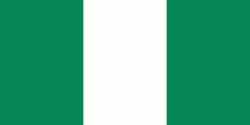Kwara State (Kwara State)
Of the 36 states of Nigeria, Kwara is the ninth largest in area, but the sixth least populous, with an estimated population of about 3.2 million as at 2016. Geographically, Kwara state is split between the West Sudanian savanna in the west, and the Guinean forest–savanna mosaic ecoregion in the rest of the state. Important geographic features of the state include rivers, with the Niger flowing along the northern border into Lake Jeba, before continuing as the border, while the Awun, Asa, Aluko, and Oyun rivers flow through the interior. In the far northwest of the state is the Borgu section of the Kainji National Park, a large national park that contains populations of grey heron, kob, hippopotamus, African bush elephant, olive baboon, and roan antelope, along with some of the last remaining West African lions on Earth. In the far southwest, a small part of the Old Oyo National Park contains crowned eagle, martial eagle, African buffalo, oribi, and patas monkey populations.
Kwara state has been inhabited for years by various ethnic groups, primarily the majority Yoruba people that live throughout the state, but there are sizeable minorities of Nupe people in the northeast, Bariba (Baatonu) and Busa (Bokobaru) peoples in the west, and a small Fulani population in Ilorin, moving through the state as nomadic herders.
In the pre-colonial period, majority of the area that is now Kwara state was part of the Oyo Empire, with part of the western portions in the Borgu Kingdoms peopled by the Bariba, Boko and Bissa people, and Nupe Kingdom (1531-1835). In the mid 1800s, the Fulani jihad annexed some part of what is now the state of Kwara and placed the area under the Gwandu sphere of the Sokoto Caliphate. In the 1890s and 1900s, British expeditions occupied the area and incorporated it into the Northern Nigeria Protectorate. The Northern Nigeria later merged into British Nigeria in 1914, before becoming independent as Nigeria in 1960. Originally, the modern-day Kwara state was a part of the post-independence Northern Region until 1967, when the region was split and the area became the West Central State. In 1976, the state was renamed Kwara state and the name remained until the 1990s, when its southeast was split off to form a part of Kogi state and its far northwest Borgu division was annexed into the Borgu division of Niger state.
Economically, Kwara state is largely based around agriculture, mainly of coffee, cotton, groundnut, cocoa, oil palm, and kola nut crops. Other key industries are services, especially in the city of Ilorin, and the livestock herding and ranching of cattle, goats, and sheep. Kwara state has the joint-twentieth highest Human Development Index in the country and numerous institutions of tertiary education.
Kwara state was created on 27 May 1967, when the Federal Military Government of General Yakubu Gowon broke the four regions that then constituted the Federation of Nigeria into 12 states. At its creation, the state was made up of the former Ilorin and Kabba provinces of the then Northern Region and was initially named the West Central State but later changed to "Kwara", a local name for the River Niger, in the Hausa language.
Kwara state has since 1976 reduced considerably in size as a result of further state creation exercises in Nigeria. On 13 February 1976, the Idah/Dekina part of the state was carved out and merged with a part of the then Benue/Plateau state to form Benue state.
On 27 August 1991, five Local Government areas, namely Oyi, Yagba, Okene, Okehi and Kogi were also excised to form part of the new Kogi state, while a sixth, Borgu Local Government Area, was merged with Niger state. The major populated local governments are Ilorin and Offa.
Kwara state has numerous mineral resources such as tourmaline, tantalite, and many mineral deposits in the northern part. Cocoa and Kolanut in the Southern parts Oke - Ero, Ekiti and Isin LGA.
Map - Kwara State (Kwara State)
Map
Country - Nigeria
 |
 |
| Flag of Nigeria | |
Nigeria has been home to several indigenous pre-colonial states and kingdoms since the second millennium BC, with the Nok civilization in the 15th century BC, marking the first internal unification in the country. The modern state originated with British colonialization in the 19th century, taking its present territorial shape with the merging of the Southern Nigeria Protectorate and Northern Nigeria Protectorate in 1914 by Lord Lugard. The British set up administrative and legal structures while practising indirect rule through traditional chiefdoms in the Nigeria region. Nigeria became a formally independent federation on 1 October 1960. It experienced a civil war from 1967 to 1970, followed by a succession of military dictatorships and democratically elected civilian governments until achieving a stable democracy in the 1999 presidential election. The 2015 general election was the first time an incumbent president failed to be re-elected.
Currency / Language
| ISO | Currency | Symbol | Significant figures |
|---|---|---|---|
| NGN | Nigerian naira | ₦ | 2 |
| ISO | Language |
|---|---|
| EN | English language |
| HA | Hausa language |
| IG | Igbo language |
| YO | Yoruba language |















